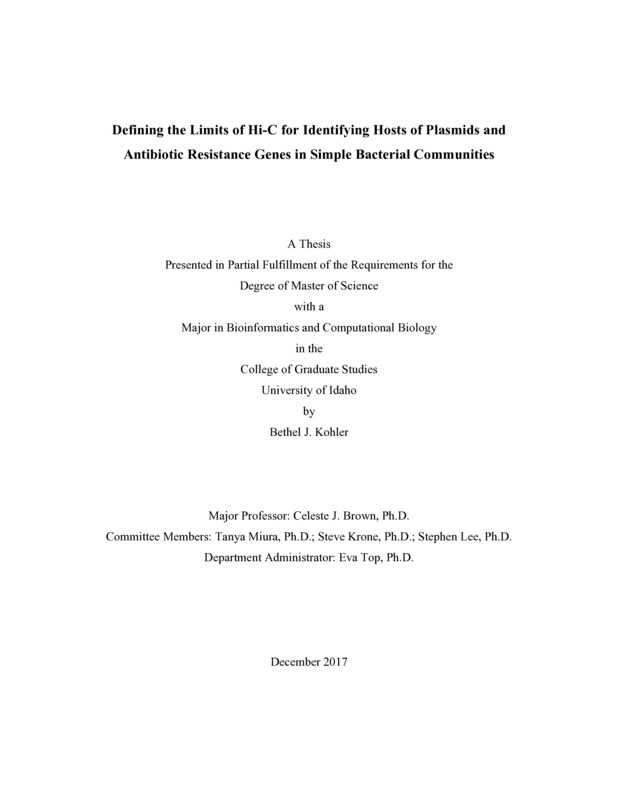Defining the Limits of Hi-C for Identifying Hosts of Plasmids and Antibiotic Resistance Genes in Simple Bacterial Communities
Kohler, Bethel. (2017-12). Defining the Limits of Hi-C for Identifying Hosts of Plasmids and Antibiotic Resistance Genes in Simple Bacterial Communities. Theses and Dissertations Collection, University of Idaho Library Digital Collections. https://www.lib.uidaho.edu/digital/etd/items/kohler_idaho_0089n_11276.html
- Title:
- Defining the Limits of Hi-C for Identifying Hosts of Plasmids and Antibiotic Resistance Genes in Simple Bacterial Communities
- Author:
- Kohler, Bethel
- Date:
- 2017-12
- Keywords:
- Antibiotic Resistance Bioinformatics Hi-C Plasmids
- Program:
- Bioinformatics & Computational Biology
- Subject Category:
- Bioinformatics; Microbiology
- Abstract:
-
The rapid spread of bacterial antibiotic resistance is a major public health threat that is making many of our known antibiotics ineffective at fighting pathogens. The horizontal transfer of antibiotic resistance genes (ARG) by mobile genetic elements such as plasmids plays a major role in this health crisis. To curb the spread of ARG, we need to identify the hosts and plasmids that carry them in the environment. Traditional metagenomic approaches have been of limited use in this because of their poor ability to link ARG to the chromosome or plasmid that carry them. Cultivation-based methods are also not effective due to the high abundance of unculturable bacteria in most ecosystems. The chromosomal conformation capture (Hi-C) approach has recently been proven useful for reconstructing individual genomes from mixed cell populations by physically linking DNA fragments that occupied the same cell prior to sequencing. However, the limits of Hi-C detection, especially in the areas of plasmid and antibiotic resistance research, have not been defined. This project tested the hypothesis that plasmid and bacterial carriers of ARG can be identified using the Hi-C method while also beginning to define its limits in these areas. Towards this end, a bioinformatics pipeline was constructed for Hi-C data analysis. Using this pipeline, the Hi-C clustering of metagenomic contigs by species can be done using a simple script implemented in R. A series of mock bacterial communities was designed to measure the limits of Hi-C detection for plasmids and ARG while mimicking realistic environmental and plasmid-transfer scenarios. The pipeline was shown to be effective for clustering the contigs from these communities by genome. Clustering based on Hi-C linkages also made it possible to identify the genetic context of ARG in bacterial communities, for instance, whether ARG were encoded on bacterial chromosomes or transmissible plasmids. Multiple plasmids could be accurately shown to be carried by the same species, the genome of a species present at as low as 5% of the community could be detected, and the same plasmid could be definitively determined to be present in multiple species when present in those species in equal amounts. This information will lead the way for future research applications using Hi-C to identify the bacterial carriers of ARG and plasmids in diverse environmental samples.
- Description:
- masters, M.S., Bioinformatics & Computational Biology -- University of Idaho - College of Graduate Studies, 2017-12
- Major Professor:
- Brown, Celeste J
- Committee:
- Miura, Tanya; Krone, Steve; Lee, Stephen
- Defense Date:
- 2017-12
- Identifier:
- Kohler_idaho_0089N_11276
- Type:
- Text
- Format Original:
- Format:
- application/pdf
- Rights:
- In Copyright - Educational Use Permitted. For more information, please contact University of Idaho Library Special Collections and Archives Department at libspec@uidaho.edu.
- Standardized Rights:
- http://rightsstatements.org/vocab/InC-EDU/1.0/

